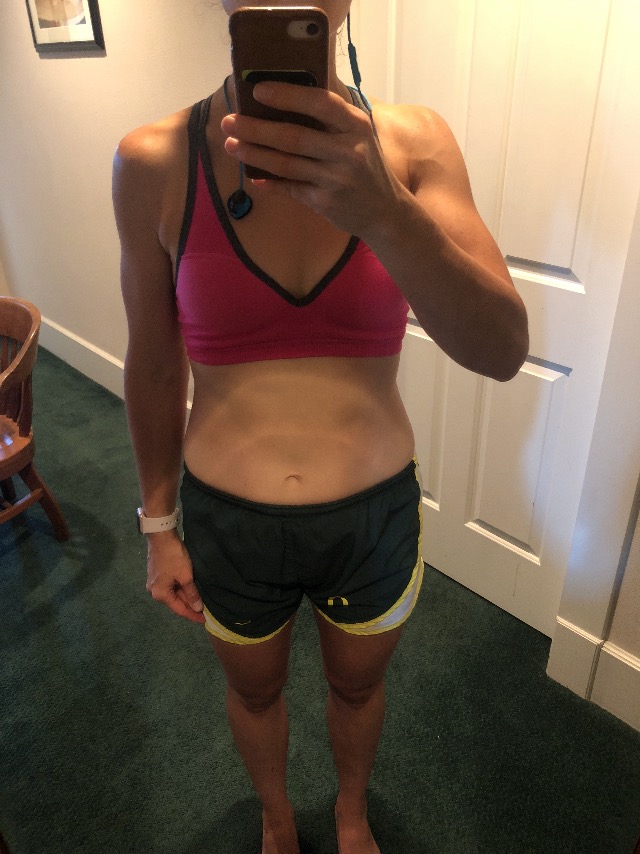📸 These were my “progress” photos.



At 37, I looked leaner and more defined than ever. But it wasn’t my first “body chapter.”
In my late teens, I was a high school athlete—strong but starting to put on weight. By college, training with the rugby team for lacrosse, I was thick and powerful. A foot injury shifted me into dance in my 20s, and later I ran for years. All the while, I was yo-yo-ing—up and down in weight from 18 onward. Add in three pregnancies, each with 40–50 pounds gained and lost, and my body had been through many seasons.
By my mid-30s, HIIT became my thing. Paired with kettlebells and Pilates, it felt like I’d finally found “the answer.” I was strong, capable, unstoppable.
But what you don’t see in these photos is that I was about to hit the wall. My terrain was already depleted: a new mercury amalgam filling, years of stress with my husband overseas, and being a mom of three under five in Ireland with no family support. (Spoiler: we moved home.)
About six months later, a camping trip and parasite exposure triggered an avalanche of food intolerances. Suddenly, I couldn’t face HIIT anymore. Not just physically, but mentally. What I now recognize as an adrenal crash showed up as a total block—my body saying: “No more.”
From the outside, I looked like “fitness success.” Inside, my mitochondria and adrenals were waving the white flag.
This is the hidden side of perimenopause and autoimmunity: looking healthy or “fit” doesn’t always equal resilience. Sometimes, it’s actually the opposite—your body is burning itself out in the name of performance.
Why Movement Matters in Perimenopause
Movement isn’t just about burning calories. It’s about preserving the very engines of your energy: your mitochondria. These tiny powerhouses inside your cells generate ATP (your cellular fuel), and they’re deeply influenced by how—and whether—you move.
Muscle Preservation: Hormonal shifts accelerate muscle loss, which can lead to weakness, slower metabolism, and insulin resistance.
Energy Production: Mitochondria thrive when challenged with the right kind of movement. This keeps energy production resilient, even when hormones fluctuate.
Autoimmune Reality: Too much intensity can tip you into days—or even weeks—of flares, fatigue, and pain.
Mitochondria-Smart Movement
Here’s what actually supports your mitochondria and respects autoimmune reality:
Strength Training (gentle, progressive)
Resistance bands, bodyweight, or light weights. Lifting doesn’t have to be heavy to protect muscle, bones, and metabolism.
Zone 2 Cardio
Brisk walking, cycling, rowing—where you can talk but not sing. This trains mitochondria to burn fat efficiently and supports blood sugar stability.
Restorative Movement
Walking, stretching, mobility, or dance. Especially crucial for autoimmune bodies—movement should nourish, not deplete.
HIIT (with caution)
High-intensity intervals can be great in sprinkles—but too much will drain reserves fast. If you dread it, or crash after, that’s not laziness. That’s your body telling you it’s not the right season for it.
Listening to Your Body
Energy is feedback, not failure. If you crash for days after exercise, that’s not a character flaw—it’s biology. In perimenopause, resilience is built with consistency and compassion, not with extremes.
Even 10–15 minutes of daily movement can stimulate mitochondrial growth and preserve muscle without overloading your system.
Movement in perimenopause isn’t about chasing aesthetics—it’s about protecting energy, preserving muscle, and honoring your body’s limits.
Your mitochondria will thank you for every nourishing walk, every gentle lift, every stretch.
Your future self doesn’t need perfection. She needs you to keep moving—even if it looks different than it did at 37.
After my fourth pregnancy, I gained another 40–50 pounds and my body shifted again. I’m slimmer now, but not the size 2 I once was. I’m strong—but in a different way. Not the “pump out a heavy weightlifting session or run 7 miles” strong, but the kind of strength that comes from sustaining, adapting, and moving with consistency. My body today reflects resilience, not punishment. And that, more than any aesthetic, is what truly carries me forward.
Thanks for journeying through this with me. If you’re ready to find a way of moving that actually works with your body instead of against it, I’m currently accepting new 1:1 clients.
Brenna May, NTP
Holistic Nutritional Therapy Practitioner • Functional Wellness
This content is for educational purposes only and is not a substitute for individualized medical advice.
Next up: Perimenopause & Minerals: How Electrolytes Protect Hydration, Adrenals & Autoimmune Resilience